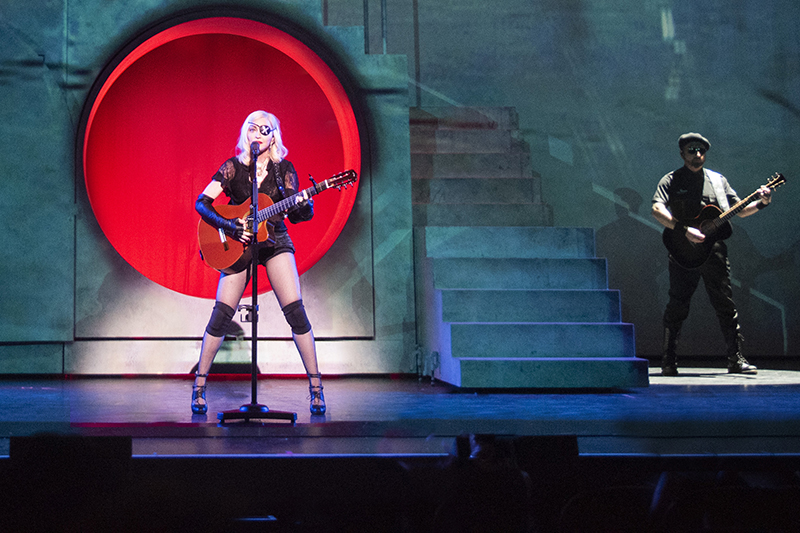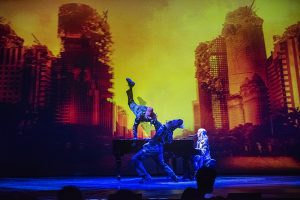REVIEW: Madonna bathes in the noise at San Francisco ‘Madame X’ finale

Madonna performs on the Madame X tour in this undated photo. Courtesy: Stufish.
SAN FRANCISCO — “Who is Madame X?” Madonna asked halfway into her two-and-a-half hour show Tuesday at Golden Gate Theatre, the final concert of a three-date residency. The show was just as much a performance art piece and a revue as a music concert. While Madonna has toured arenas and stadiums for years (and hasn’t played smaller clubs since 1985), The Madame X tour was an extremely more intimate affair. But intimate didn’t mean scaled back. If anything, it showed Madonna thinks outside the box.
The answer to the question was the crux of the show, and it was one she answered over and over again. Madame X, a persona the 61-year-old took on after moving to Lisbon, Portugal several years ago, is everything all at once. She’s a sinner, a saint, a head of state and a whore.
“But so are all of you,” Madonna said.
While the concept wasn’t always cleanly communicated, and some may have left scratching their heads, it showed that Madonna wasn’t done messing with people’s heads. And that was made clear at the outset when the words of novelist James Baldwin were projected onto the stage: “Artists are here to disturb the peace.”
Madonna did plenty of disturbing, and was usually pretty blunt about it, even when it came to calling out her fans. The Madame X tour is camera-free and the ringleader took that seriously, twice announcing she thought someone in the audience had a camera, when she was annoyed by a fan’s lit-up hat and demanded he turn it off, or that an exit door was opening and closing frequently. There were moments of levity as well, such as when she asked for someone to bring her a drink. A fan in the front row named Brad, an Army drill sergeant from Kansas City, brought her a beer, which she immediately deemed warm. She poked some fun at him, but it made her seem more approachable. This sort of interaction wouldn’t have worked at an arena show.
Madonna took the stage at 11 p.m. and played until 1:30 a.m. The concert was broken up into five acts, the first of which kicked off with “God Control,” the first of 12 cuts from the Madame X album. In fact, only a handful of older songs made the set, and most of those were shortened or reimagined.
Madonna and a handful of dancers were dressed in 18th-century-style military uniforms, complete with a hat she could have borrowed from the local production of “Hamilton.” She appeared behind a translucent screen showing a tattered U.S. flag that morphed into the interior of a cathedral. Eventually riot police showed up while the video screen showed footage of civil unrest. At the back of the stage stood a double staircase that reached nearly to the ceiling and was composed of pieces that would be moved around throughout the show to form other backdrops.
Every available surface was used as a projection mapping screen, and the show production was amazing. It pushed the performance from concert territory and closer to a Broadway play. Appreciating that was probably important to fully appreciate the show as a whole. If you came expecting to hear the hits faithfully recreated, this show wasn’t for you. If you came expecting Madonna to theorize about the length and girth of Frank Sinatra’s penis and make some other crude genitalia jokes, well, you probably left happy.
After the opening song ended with projections of bullets raining down and Madonna demanding that everyone “WAKE UP,” a steady stream of new material followed.
On “Dark Ballet,” she was joined by string trio dressed as nuns and a pianist wearing a gas mask. The riot police dancers showed up again and this time carried a combative Madonna across the stage. “Human Nature,” from 1994’s Bedtime Stories, got a jazzy treatment and and ended with Madonna leading the audience in an a cappella verse from “Express Yourself.”
Between the first and second acts there was a bit where Madonna changed outfits while standing behind a a screen that had been wheeled on stage. Now dressed in a black trench coat and clad in black sunglasses, she perfectly matched nearly a dozen dancers, who also had blond hair. On “Vogue,” the group climbed up and down the reconfigured stair structures. There was also a part where Madonna was captured by fedora-wearing agents and questioned in a room with a swinging lightbulb during “I Don’t Search I Find.”
In another segment, she pulled out a Polaroid camera and took a picture. She then pretended to sell the picture—we presume it was part of the act—to a fan in the front row for $4,000 cash. Either “Alan who draws comic books” was in on the bit or he’s freshly out of some dough but has a good story to tell.
Madonna sang just one verse of “Papa Don’t Preach” before halting the song to make a statement.
“What did you think of me not keeping the baby?” she asked before going into a talk about reproductive rights. That segment ended with “American Life,” on which she was accompanied by a guitarist and dancer, both dressed in commando uniforms.
The third act was the most interesting. Following an on-stage reenactment of a Navy funeral procession and a mock fight between two of the seamen carrying a casket, the video transitioned to crashing waves. Women dressed in African folk garments marched down the aisles from the back of the room to the stage singing and clapping. This was the Batukadeiras Orchestra, a group of musicians from an island nation off the coast of northwest Africa called Cape Verde. The country was central to the slave trade and the visuals during “Batuka” underscored the heartbreak of the subject matter.
Over the next several songs she sang in Portuguese and in Cape Verdean Creole.
Madonna then explained how moving to Portugal broke her out of a creative funk.
“I moved to Lisbon to be a soccer mom,” she said. “But I met people. I learned Portuguese.”
She spoke of meeting fado singer Celeste Rodrigues and being introduced to that type of music. Rodrigues passed away recently, but Madonna played a bit of one of her songs with Rodrigues’ 16-year-old grandson, who played a stringed instrument similar to a Turkish saz. Other highlights during this segment included the poppy “Crazy” and “Medellín,” which included a group cha-cha dance while a the song’s featured artist, “Maluma,” appeared on video.
The staging for this segment was also top-notch, with a colorful villa, archways and all, set against a starry nighttime sky. On “Extreme Occident,” several of the smaller stage pieces spun around in circles as if they were animated appliances from The Beast’s castle (from “Beauty and the Beast”).
The penultimate act was highlighted by a fully realized version of “Frozen,” from 1998’s Ray of Light. Set behind a projection of her daughter Lourdes doing an interpretive dance, Madonna was alone on stage, this time letting her voice shine by itself. Following several other songs that saw projections of a ruined metropolis, she brought the show with “Like a Prayer” wearing a black robe bedazzled with crosses, leading a choir stationed on the rebuilt staircases to form an “X,” and Madame X cut “I Rise.”
While the performance didn’t change the common perception of Madame X as a disorganized album, Madonna seemed to relish in the noise of it all. She’s using her art to highlight injustice, show love and express herself. She’s doing it in the way she knows best: through contradiction.
“There’s so many paradoxes in this world,” Madonna said Tuesday, both as an observation and a summary of the Madame X Tour.
Follow editor Roman Gokhman at Twitter.com/RomiTheWriter.

